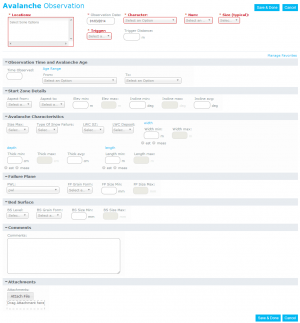Avalanche observations
| REQUIREMENTS | |
| Permission | All users |
| Connectivity | Online and offline |
Avalanche observations are detailed records of avalanche occurrences as described in OGRS (2014) section 3. As in the past, InfoEx supports both the entry of single and multiple events into a single record.
Mandatory fields
Mandatory field are highlighted with a red outline and label. Incorrectly completed mandatory field will result in a validation error on submission.
| NOTE | If you cannot see the highlighted field in the favourite section of your observation entry form, open all of the sections at the bottom to find the field that is causing the issue. |
| Name | Mandatory | Comment |
| Location | Always | Location of observation; can be a single or combinations of locations of any type. |
| ObservationDate | Always | Date of observation |
| Character | Always | Character of avalanche. See Avalanche character definition table for more information on avalanche problems. |
| Num | Always | Number of avalanches included in this observation. |
| Size (typical) | Always | Typical size of avalanches included this observation. |
| Trigger | Always | Trigger type for repored avalanches according to definitions described in OGRS. |
All supported fields
Insert Link to Best Practice DocumentSpecial functionality
In addition to associating avalanche observations with a predefined location from your location catalog, it is also possible to drop a pin or draw a polygon on a map to indicate exactly where the avalanche occurred. See Providing the exact location of an avalanche or snowpack observation for more information on how to drop a pin.
If you have a photo associated with your selected location a pencil icon will appear next to the pin. This allows you to draw on the photo and submit the photo with the overlay you have drawn with your observation. Overlays can be viewed in the Photo Overlay Viewer.
Related documents
Other observation types
- Weather observations
- Field summaries
- Avalanche observations
- Avalanche summaries
- Snow Profiles
- Terrain management
- General messages
- Avalanche control (additional subscription required)
Related functionality
- Difference between observations and assessments
- Entering and submitting observations overview
- Customizing observation entry forms
Functionality tested by
- Jan. 2, 2014: Pascal Haegeli
